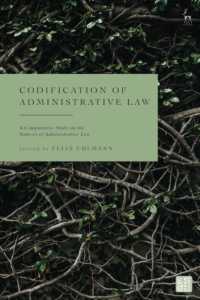- ホーム
- > 洋書
- > 英文書
- > Science / Mathematics
Full Description
This second part of the sixth volume of Joseph Needham's great enterprise is the first to be written by a collaborator. Francesca Bray, working closely with Dr Needham, has produced the most comprehensive study of Chinese agriculture to be published in the West. From a huge mass of source material, often confusing and obscure, and from first-hand study in China, she brings order and illumination to a crucial area of Chinese technological development. The main body of the book is an account of the technological history of agriculture, with major sections devoted to field systems, implements and techniques (sowing, harvesting, storing) and crop systems (what has grown and where and how crops rotated). The concluding section contrasts Europe's Agricultural Revolution with agrarian change in North China in the Han and with the 'Green Revolution' in South China in the Sung. In the theoretical analysis which concludes this section we find a vital contribution to the elucidation of the main question posed by Dr Needham's work: why did the Scientific Revolution which transformed the world take place in Europe and not in China?
Contents
List of illustrations; List of tables; List of abbreviations; Author's note; Part 41. Agriculture; a. Introduction: 1. General characteristics of Chinese agriculture; 2. Agricultural regions; 3. Origins of Chinese agriculture; b. Sources: 1. The yüeh ling or agricultural calendars; 2. Agricultural treatises; 3. State-commissioned compilations; 4. Monographs; 5. Supplementary sources; 6. The content of the Chinese sources, and the implications for historical interpretation; 7. A comparison with the European tradition; c. Field systems: 1. Land clearance and reclamation; 2. Shifting cultivation; 3. Permanent fields; d. Agricultural implements and techniques: 1. Tillage implements; 2. Sowing; 3. Fertilisation; 4. Weeding and cultivation; 5. Harvesting, threshing and winnowing; 6. Grain storage; e. Crop systems: 1. Crop rotation; 2. Millets, sorghum and maize; 3. Wheat and barley; 4. Rice; 5. Legumes; 6. Oil crops; 7. Tuber crops; 8. Fibre crops; 9. Vegetables and fruits; f. Conclusions: Agricultural changes and society - stagnation or revolution?: 1. Did China contribute to Europe's Agricultural Revolution?; 2. Agricultural revolution in China?; 3. Development or change?; Bibliographies; General index.






